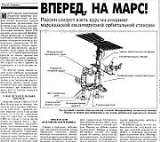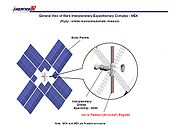
Mars Piloted Orbital Station
Encyclopedia

Russia
Russia or , officially known as both Russia and the Russian Federation , is a country in northern Eurasia. It is a federal semi-presidential republic, comprising 83 federal subjects...
manned orbital mission to Mars
Mars
Mars is the fourth planet from the Sun in the Solar System. The planet is named after the Roman god of war, Mars. It is often described as the "Red Planet", as the iron oxide prevalent on its surface gives it a reddish appearance...
, with several proposed configurations, including using a nuclear reactor
Nuclear reactor
A nuclear reactor is a device to initiate and control a sustained nuclear chain reaction. Most commonly they are used for generating electricity and for the propulsion of ships. Usually heat from nuclear fission is passed to a working fluid , which runs through turbines that power either ship's...
to run an electric rocket engine. A 30-volume draft proposal was produced in 2005. Design for the ship proposed to be ready in 2012, and the ship itself in 2021.
Mission Scenario

Robotic spacecraft
A robotic spacecraft is a spacecraft with no humans on board, that is usually under telerobotic control. A robotic spacecraft designed to make scientific research measurements is often called a space probe. Many space missions are more suited to telerobotic rather than crewed operation, due to...
designed to study Mars both from its orbit and on its surface. Some of these spacecraft would be carried onboard the station. The station would reach the Mars orbit from where its crew will research Mars by operating the aforementioned robots (this is why the mission called ‘hybrid’). No humans will land on Mars during this mission. Since robots will be controlled by Marpost crewmembers from Martian orbit it will eliminate one of the problems standing in the way of effective control of such machines by people on Earth, which is a delay of radio signal because of the long distance between Mars and Earth
Earth
Earth is the third planet from the Sun, and the densest and fifth-largest of the eight planets in the Solar System. It is also the largest of the Solar System's four terrestrial planets...
. The samples of Martian soil will later be delivered by these robots to Marpost and subsequently brought back to Earth. The whole duration of the mission would be approximately 2.5 years with one month of Marpost work in Mars orbit. Its main goal would be to prove that people can survive a lengthy trip through ‘deep space’ and effectively perform their professional responsibilities, including operating the spacecraft and conducting research activities during such mission.
The idea of this ‘hybrid’ mission was first advanced by US-trained Russian space policy expert Dr. Yuri Karash (he got his Ph.D. in Space Policy and International Relations from the American University in Washington, D.C. in 1997) in his article published in the Russian Nezavisimaya Gazeta on October 18, 2000 under the title Vperyod, Na Mars! Rossii sleduyet vzyat kurs na sozdaniye marsianskoi pilotiruemoy orbitalnoy stantsii [Onward, to Mars! Russia needs to set a course toward the development of Martian Piloted Orbital Station]. Dr. Karash claimed that Russia while continuing its participation in the International Space Station program should build the rest of Russian modules for the station but instead of attaching them to the ISS, assemble them in orbit as an autonomous complex and launch it to Mars with a crew onboard. Dr. Karash also gave this space complex its unofficial name MARPOST. He also believes that Marpost could pave the way for a joint Russian-American mission to the Martian surface. Russia, capitalizing on its extensive experience in building and operating long-term orbital space stations would build a trans-planetary spacecraft while America capitalizing on its experience gained during Apollo Moon landing program would build a Mars landing module.
The idea of Marpost was picked up by Raketno-Kosmicheskaya Korporatsiya (Rocket-Space Corporation) Energia
Energia
Energia was a Soviet rocket that was designed by NPO Energia to serve as a heavy-lift expendable launch system as well as a booster for the Buran spacecraft. Control system main developer enterprise was the NPO "Electropribor"...
, the Russian leading space developer and builder of human spaceflight hardware, particularly by one of its main designers Dr. Leonid Gorshkov.
Evolution of the project

Saturn V
The Saturn V was an American human-rated expendable rocket used by NASA's Apollo and Skylab programs from 1967 until 1973. A multistage liquid-fueled launch vehicle, NASA launched 13 Saturn Vs from the Kennedy Space Center, Florida with no loss of crew or payload...
moon booster by its payload capacity. Later however, in order to lower the cost of the mission, the elements of MEK were redesigned to be launched by Proton or Angara (still in development as of 2007) type of boosters. The overall weight of MEK is about 400 tons. It will be powered by ion thruster
Ion thruster
An ion thruster is a form of electric propulsion used for spacecraft propulsion that creates thrust by accelerating ions. Ion thrusters are categorized by how they accelerate the ions, using either electrostatic or electromagnetic force. Electrostatic ion thrusters use the Coulomb force and...
engines.

